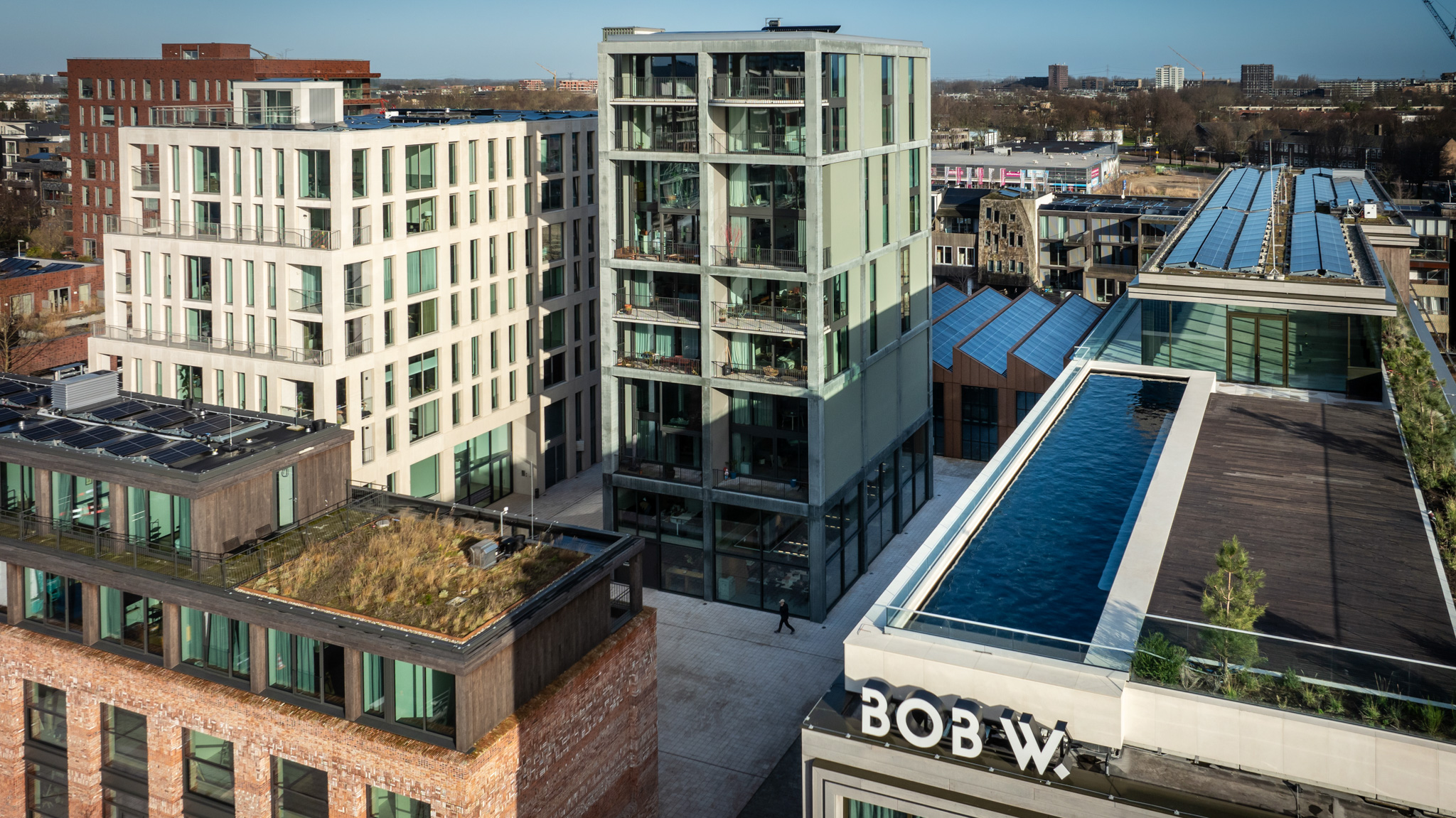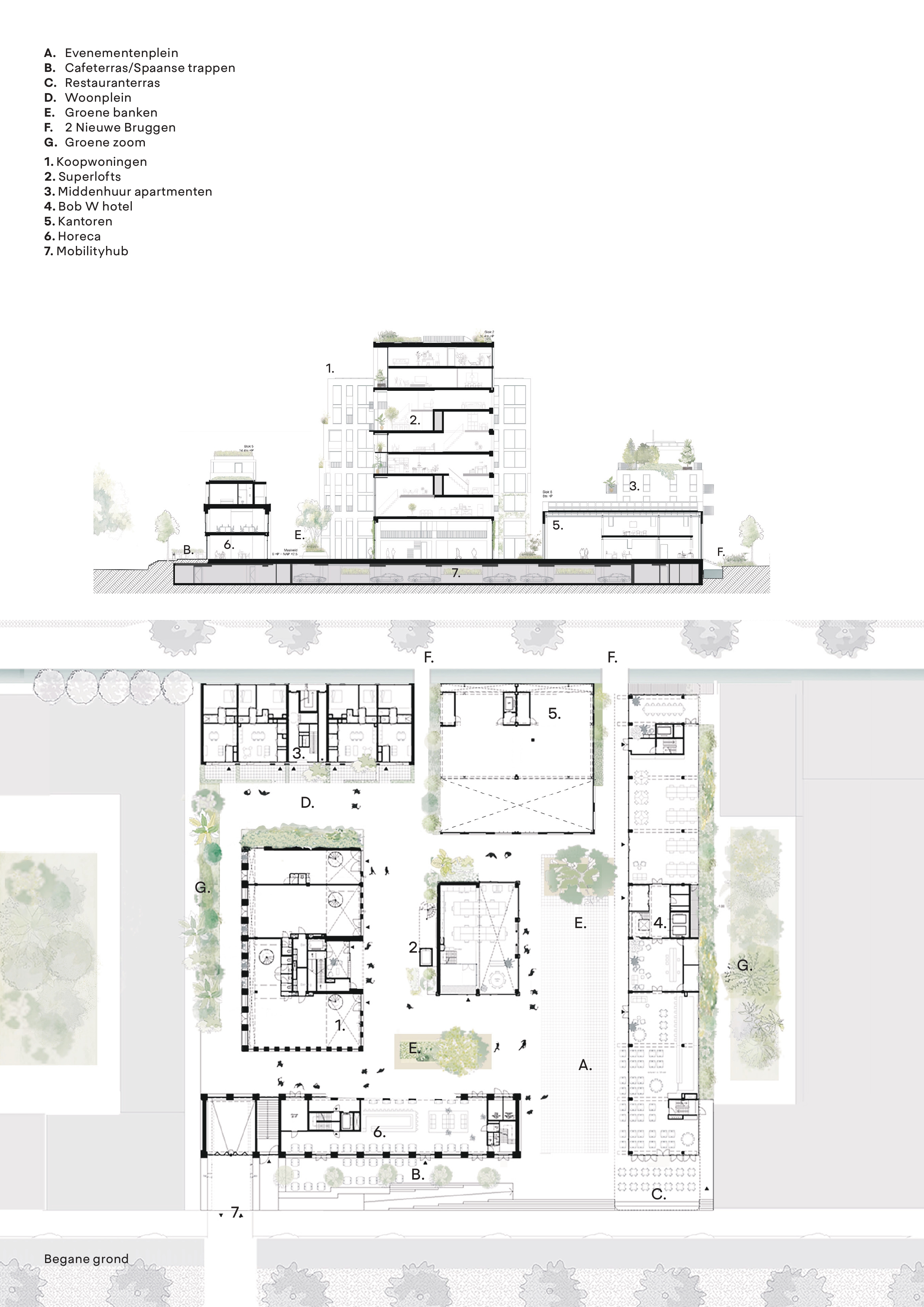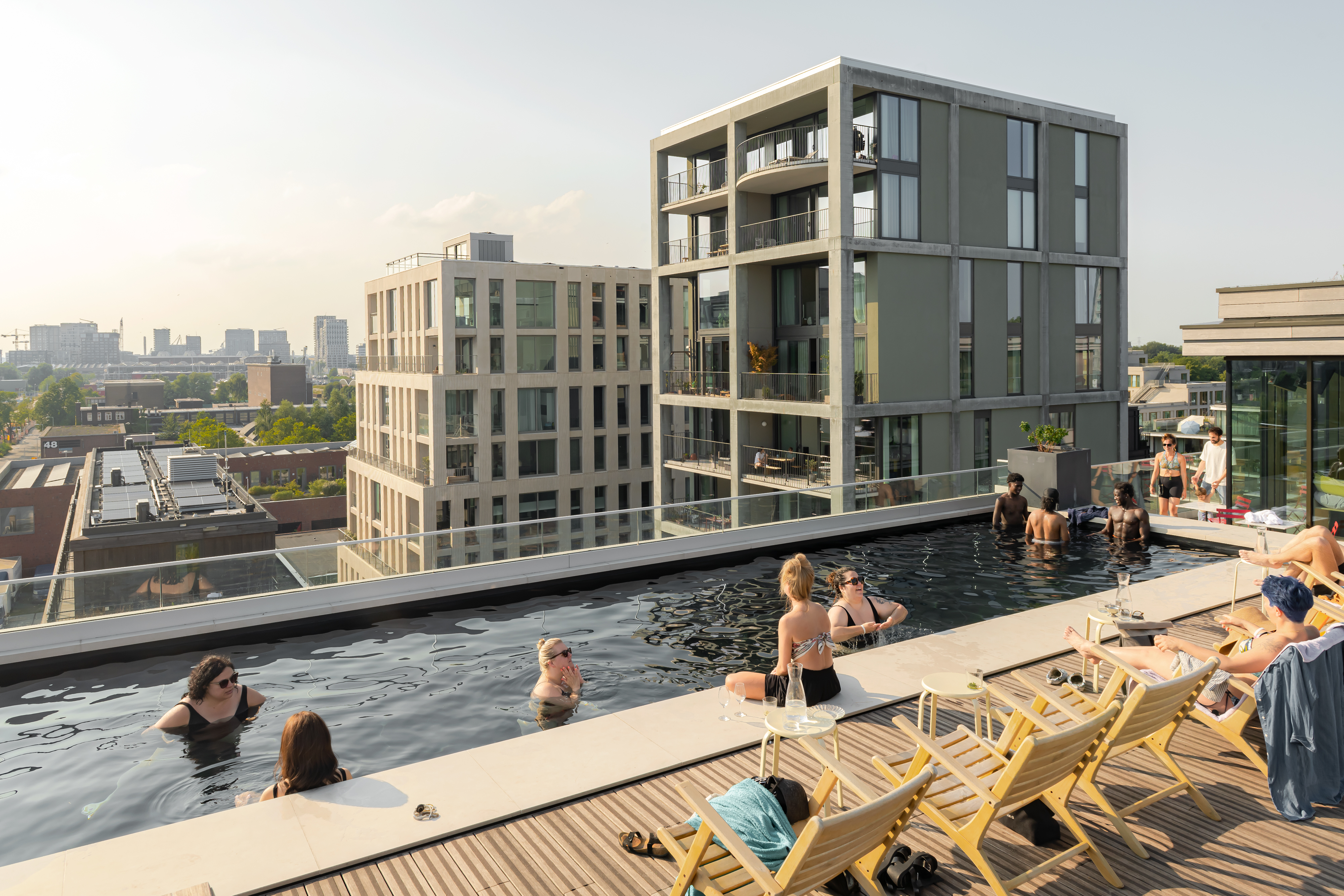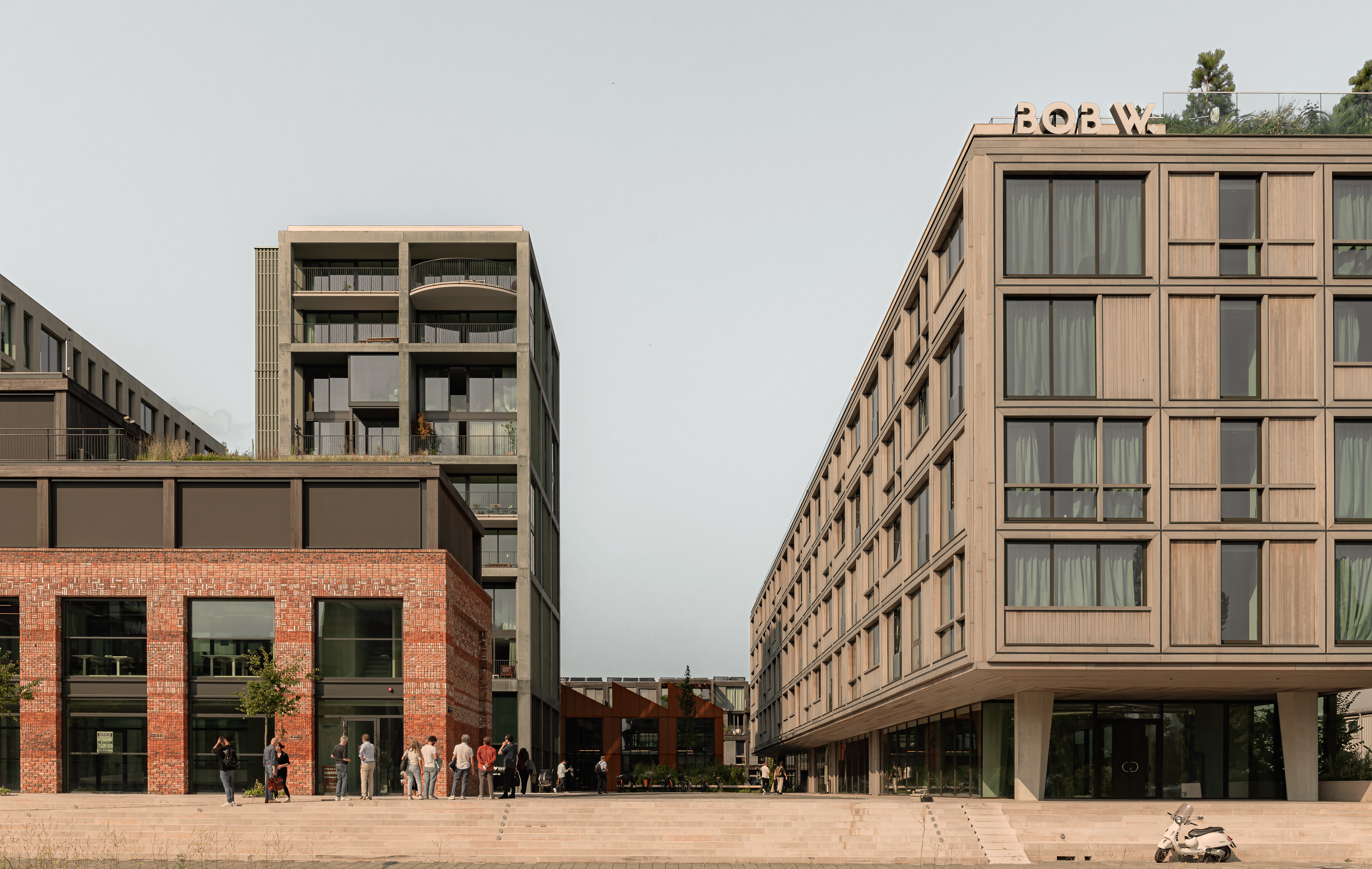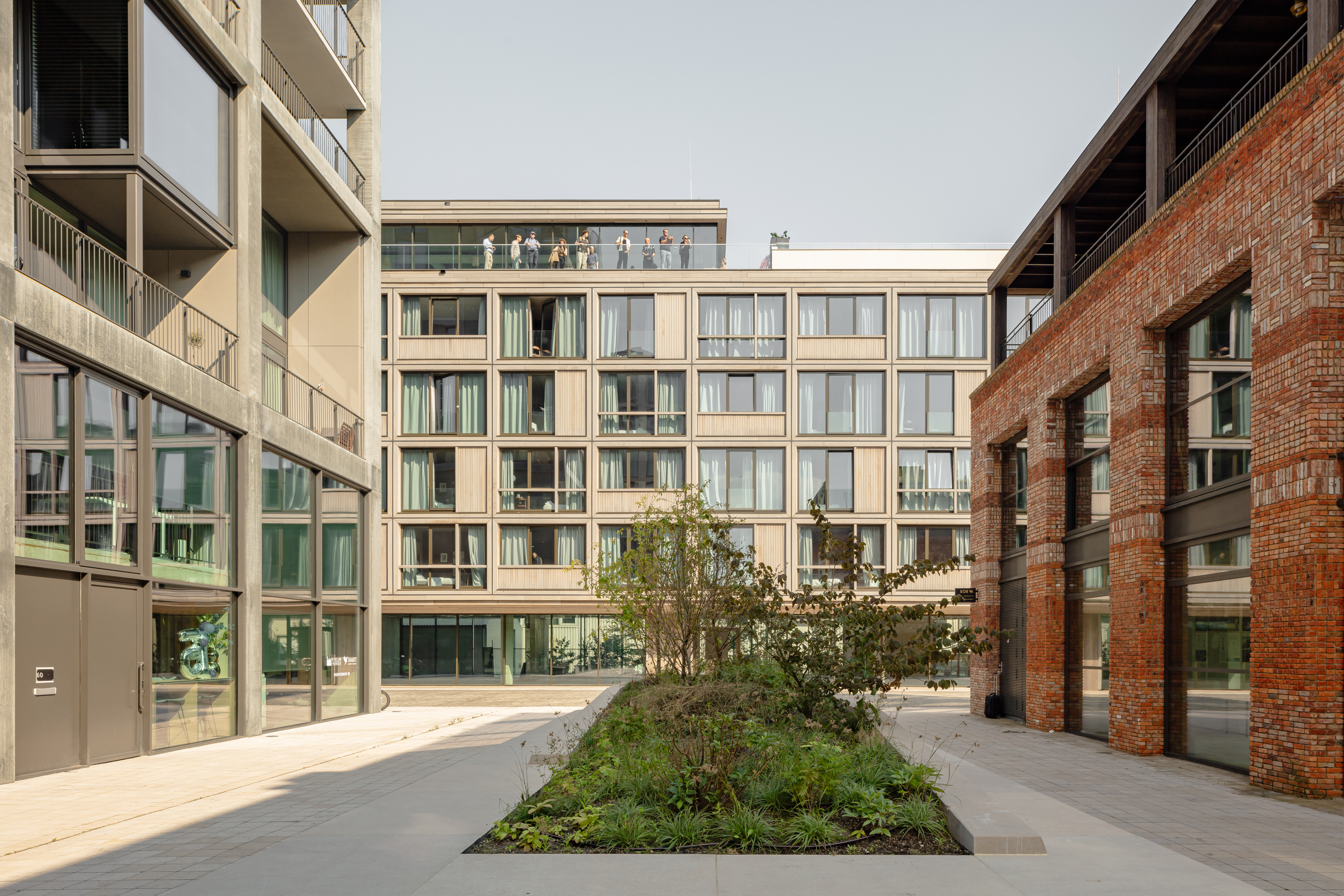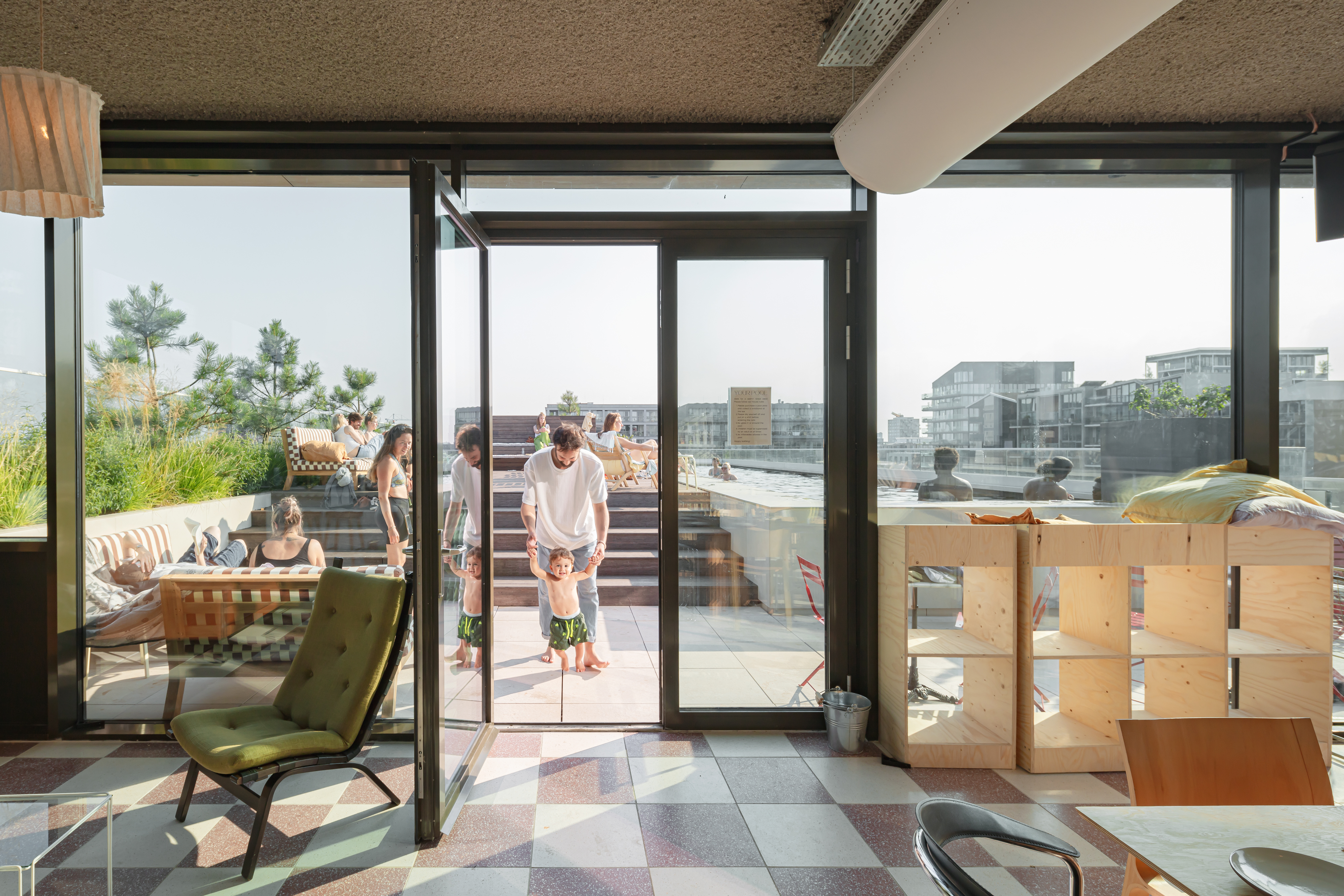Reconnecting with nature
Republica
Republica
Republica is a pioneering circular urban village in Buiksloterham, Amsterdam. It redefines sustainable city living by integrating living, working, sports, hospitality, and e-mobility in a car-free super block. With energy-positive buildings, smart grids, rainwater storage, and food waste-to-energy systems, Republica creates a vibrant, self-sufficient community with green plazas, terraces, and flexible spaces.
Netherlands
Local
Amsterdam
Mainly urban
It refers to other types of transformations (soft investment)
Yes
2024-01-01
Yes
ATELIER Positive Energy Districts
No
Yes
Yes
Yes
As a representative of an organisation
Republica is a circular urban village and a pioneering project in the sustainable transformation of Buiksloterham, a former industrial area in Amsterdam North. This high-density, car-free development combines living, working, sports, hospitality, and e-mobility within a cohesive urban block of six sculptural buildings and green public spaces. The aim of Republica is to build the future of collective living with a mixed-use concept that fosters community connection and sustainable living.
The project’s key target groups include urban dwellers, young professionals, families, and entrepreneurs seeking a modern, environmentally conscious lifestyle. The achieved outcomes reflect Republica’s ambition to be an energy-positive district. The development includes nearly 1,500 m² of solar panels, a 1,2 mWh battery, a smart grid for energy sharing, and rainwater storage solutions, supporting a self-sufficient ecosystem. Republica is part of the EU-funded ATELIER Positive Energy Districts initiative, making it a real-life testing ground for sustainable innovations. The result is peak-shaving of Energy demand, lower energy use and water use and less water overlet to the urban sewage system
Through adaptive design and the principles of Open Building, Republica is a model for circularity, with buildings designed to evolve over time and reduce construction waste. By fostering inclusion, sustainability, and a high-quality urban experience, Republica demonstrates the future of resilient, circular living spaces.
The project’s key target groups include urban dwellers, young professionals, families, and entrepreneurs seeking a modern, environmentally conscious lifestyle. The achieved outcomes reflect Republica’s ambition to be an energy-positive district. The development includes nearly 1,500 m² of solar panels, a 1,2 mWh battery, a smart grid for energy sharing, and rainwater storage solutions, supporting a self-sufficient ecosystem. Republica is part of the EU-funded ATELIER Positive Energy Districts initiative, making it a real-life testing ground for sustainable innovations. The result is peak-shaving of Energy demand, lower energy use and water use and less water overlet to the urban sewage system
Through adaptive design and the principles of Open Building, Republica is a model for circularity, with buildings designed to evolve over time and reduce construction waste. By fostering inclusion, sustainability, and a high-quality urban experience, Republica demonstrates the future of resilient, circular living spaces.
Urban Village
Circular
Positive Energy District
Open Building
Sustainable design
Sustainability is central to Republica’s design and operations, focusing on circularity, energy efficiency, and resource-conscious construction. The project follows the Open Building principles, allowing for flexible and adaptive use of spaces over time, significantly reducing construction waste and extending the lifecycle of each structure. Republica achieves an impressive MPG score of 8.4, reflecting its low environmental impact.
Republica is part of the EU-funded ATELIER Smart City initiative, which focuses on developing Positive Energy Districts. In collaboration with TNO, the European Union, and the Municipality of Amsterdam. Republica serves as a real-life testing ground for innovative sustainable solutions. These partners closely monitor the project’s energy performance and resource management, ensuring its long-term success and scalability.
The buildings are constructed using sustainable materials such as recycled brick, recycled stone, renewable wood, bamboo and Corten steel. Republica is designed as a Positive Energy District, equipped with 1,500 m² of solar panels, a smart grid, and a 1,2 mWh battery that ensures efficient energy management and reduces CO₂ emissions. Rainwater storage systems help prevent flooding and mitigate the urban heat island effect, while food waste is processed into biogas and valuable minerals like phosphate, contributing to a local circular economy.
Sustainable mobility solutions are also an integral part of Republica’s design. The underground parking includes charging stations for electric vehicles and electric bikes, promoting environmentally friendly transport. As part of this innovative ecosystem, Republica offers a replicable model for circular and resilient urban living.
In the spaces plants and vegetation, birds- and batsnest are integrated. We boost the green ecosystem with this. Plants reduces heat-stress and supply shelter and food for animals.
Republica is part of the EU-funded ATELIER Smart City initiative, which focuses on developing Positive Energy Districts. In collaboration with TNO, the European Union, and the Municipality of Amsterdam. Republica serves as a real-life testing ground for innovative sustainable solutions. These partners closely monitor the project’s energy performance and resource management, ensuring its long-term success and scalability.
The buildings are constructed using sustainable materials such as recycled brick, recycled stone, renewable wood, bamboo and Corten steel. Republica is designed as a Positive Energy District, equipped with 1,500 m² of solar panels, a smart grid, and a 1,2 mWh battery that ensures efficient energy management and reduces CO₂ emissions. Rainwater storage systems help prevent flooding and mitigate the urban heat island effect, while food waste is processed into biogas and valuable minerals like phosphate, contributing to a local circular economy.
Sustainable mobility solutions are also an integral part of Republica’s design. The underground parking includes charging stations for electric vehicles and electric bikes, promoting environmentally friendly transport. As part of this innovative ecosystem, Republica offers a replicable model for circular and resilient urban living.
In the spaces plants and vegetation, birds- and batsnest are integrated. We boost the green ecosystem with this. Plants reduces heat-stress and supply shelter and food for animals.
Aesthetics and adaptability are central to Republica’s design, merging industrial heritage with contemporary refinement while embracing the Open Building philosophy in key elements. The soft-green concrete tower exemplifies this concept through its adaptable core and shell structure, featuring Superlofts that allow residents to radically customize their interiors. This flexibility ensures that the building can evolve over time, reducing waste and prolonging its lifecycle.
The six sculptural buildings form a cohesive urban ensemble, each with its own unique character while contributing to a shared architectural identity. The white residential block, built with specially profiled, partly recycled concrete, offers a timeless, robust appearance. The apartment-hotel building is clad in warm wooden facades sourced from renewable materials, while the warehouse office is made of durable Corten steel with extra clear height, making it suitable for various uses, including light manufacturing. The brick façade of the café and co-work building is constructed from recycled bricks with manipulated textures and patterns, creating a distinct tactile experience.
Public spaces are designed to foster a strong sense of community and belonging. The central village square is paved with demountable partly recycled natural stone, surrounded by green terraces, trees, and lively seating areas which also act as a sponge for stormwater storage. The wide ‘Spanish Steps’ of Buiksloterham offer a sunny gathering spot, contributing to the public realm’s Southern European flair.
This combination of robust forms, high-quality detailing, and adaptable architecture creates a rich and engaging environment for living, working, and social interaction. Republica’s aesthetic vision is both timeless and future-oriented, ensuring a high quality of experience for all users while maintaining a commitment to sustainability and circular design.
The six sculptural buildings form a cohesive urban ensemble, each with its own unique character while contributing to a shared architectural identity. The white residential block, built with specially profiled, partly recycled concrete, offers a timeless, robust appearance. The apartment-hotel building is clad in warm wooden facades sourced from renewable materials, while the warehouse office is made of durable Corten steel with extra clear height, making it suitable for various uses, including light manufacturing. The brick façade of the café and co-work building is constructed from recycled bricks with manipulated textures and patterns, creating a distinct tactile experience.
Public spaces are designed to foster a strong sense of community and belonging. The central village square is paved with demountable partly recycled natural stone, surrounded by green terraces, trees, and lively seating areas which also act as a sponge for stormwater storage. The wide ‘Spanish Steps’ of Buiksloterham offer a sunny gathering spot, contributing to the public realm’s Southern European flair.
This combination of robust forms, high-quality detailing, and adaptable architecture creates a rich and engaging environment for living, working, and social interaction. Republica’s aesthetic vision is both timeless and future-oriented, ensuring a high quality of experience for all users while maintaining a commitment to sustainability and circular design.
Inclusion and accessibility are at the core of Republica’s design, promoting social cohesion, safety, and equitable access for all users. The car-free super block enhances livability and social interaction by prioritizing pedestrian spaces and shared public areas. The ground level remains open and vibrant, with all technical functions—such as parking, bike storage, waste separation, and logistics—concealed in a semi-underground garage, ensuring the streetscape is welcoming and accessible from all sides also by making two extra bridges.
Republica follows the principles of design for all, ensuring that public spaces are easily accessible for people of all ages and abilities. Seating areas, wide pathways, and multiple access points create a highly inclusive environment. The ‘Spanish Steps’ provide a multifunctional space that invites gathering and connection while being thoughtfully designed for accessibility.
Housing diversity plays a key role in fostering inclusion. The project offers a wide range of housing types, from Superlofts in the soft green concrete tower, where residents can customize their living spaces, to mid- and long-stay apartments, and more conventional rental and purchase options. One building is entirely dedicated to mid rent. This diversity caters to different life stages and socio-economic groups, making Republica a true mixed community.
The project’s energy cooperative is another example of inclusive governance. All residents and users of Republica are members of this cooperative, which manages the shared smart grid and energy resources. This participatory model fosters a sense of shared responsibility and community engagement, empowering residents to take an active role in the project’s sustainability goals.
By focusing on inclusivity in both physical design and governance, Republica sets a new standard for equitable urban living, creating a community that is welcoming, adaptable, and resilient to the challenges of the future.
Republica follows the principles of design for all, ensuring that public spaces are easily accessible for people of all ages and abilities. Seating areas, wide pathways, and multiple access points create a highly inclusive environment. The ‘Spanish Steps’ provide a multifunctional space that invites gathering and connection while being thoughtfully designed for accessibility.
Housing diversity plays a key role in fostering inclusion. The project offers a wide range of housing types, from Superlofts in the soft green concrete tower, where residents can customize their living spaces, to mid- and long-stay apartments, and more conventional rental and purchase options. One building is entirely dedicated to mid rent. This diversity caters to different life stages and socio-economic groups, making Republica a true mixed community.
The project’s energy cooperative is another example of inclusive governance. All residents and users of Republica are members of this cooperative, which manages the shared smart grid and energy resources. This participatory model fosters a sense of shared responsibility and community engagement, empowering residents to take an active role in the project’s sustainability goals.
By focusing on inclusivity in both physical design and governance, Republica sets a new standard for equitable urban living, creating a community that is welcoming, adaptable, and resilient to the challenges of the future.
Citizen involvement and collaboration with civil society have been integral to Republica’s development, ensuring that the project reflects the needs and aspirations of its future users.
The energy cooperative model is a key component of this inclusive approach. All residents and users of Republica are members of the cooperative, which manages the shared smart grid and energy infrastructure. This governance structure empowers citizens to make decisions on energy use, resource sharing, and sustainability initiatives, promoting a collective sense of responsibility for the project’s long-term success. Through monitoring, people are encouraged to use energy at off-peak hours.
As part of the Smart City ATELIER research program, Republica also functions as a living lab for sustainable urban innovation. Citizens, together with partners such as TNO, the European Union, and the Municipality of Amsterdam, are actively involved in monitoring and optimizing energy performance and resource management. Their feedback is crucial in refining the project’s systems and ensuring continuous improvement.
Public spaces within Republica are designed to encourage interaction and engagement, with accessible green areas, shared seating spaces, and community amenities that invite spontaneous social connections. Initiatives such as community gardens and cultural activities contribute to the vibrancy and social cohesion of the neighborhood. This close collaboration with citizens has ensured that Republica is not just a housing project, but a thriving, inclusive community shaped by its residents and users.
The energy cooperative model is a key component of this inclusive approach. All residents and users of Republica are members of the cooperative, which manages the shared smart grid and energy infrastructure. This governance structure empowers citizens to make decisions on energy use, resource sharing, and sustainability initiatives, promoting a collective sense of responsibility for the project’s long-term success. Through monitoring, people are encouraged to use energy at off-peak hours.
As part of the Smart City ATELIER research program, Republica also functions as a living lab for sustainable urban innovation. Citizens, together with partners such as TNO, the European Union, and the Municipality of Amsterdam, are actively involved in monitoring and optimizing energy performance and resource management. Their feedback is crucial in refining the project’s systems and ensuring continuous improvement.
Public spaces within Republica are designed to encourage interaction and engagement, with accessible green areas, shared seating spaces, and community amenities that invite spontaneous social connections. Initiatives such as community gardens and cultural activities contribute to the vibrancy and social cohesion of the neighborhood. This close collaboration with citizens has ensured that Republica is not just a housing project, but a thriving, inclusive community shaped by its residents and users.
Republica’s development involved a wide range of stakeholders at local, regional, national, and European levels, ensuring a holistic and multi-disciplinary approach to its design and implementation. Each stakeholder brought unique expertise and resources, contributing to the project’s success.
At the European level, Republica is part of the EU-funded ATELIER Smart City initiative, which focuses on developing Positive Energy Districts. In collaboration with the European Union, TNO, and other research partners, Republica serves as a testing ground for innovative solutions in circularity and energy efficiency. These partners play a vital role in monitoring energy production, consumption, and resource management, providing valuable data to improve performance and scalability.
At the local level, the Municipality of Amsterdam has been an essential partner in facilitating the project’s integration into the Buiksloterham district’s broader circular economy ambitions. The municipality provided regulatory support, ensured alignment with local sustainability goals like use of sewage as bio-gas, and facilitated citizen engagement through public consultations.
Private stakeholders, local contractors and material suppliers, contributed to the realization of Republica’s circular building approach. Collaboration with innovative companies like Spectral specializing in renewable materials and energy systems enabled the project to incorporate advanced technologies such as the smart grid, 1,2 MWh battery, and food waste-to-energy systems.
The involvement of these diverse stakeholders created a dynamic exchange of knowledge and expertise, resulting in a project that bridges multiple scales—from local community building to European research collaboration. This multi-level partnership model not only strengthens Republica’s outcomes but also serves as a replicable example for other cities aiming to implement circular and sustainable developments.
At the European level, Republica is part of the EU-funded ATELIER Smart City initiative, which focuses on developing Positive Energy Districts. In collaboration with the European Union, TNO, and other research partners, Republica serves as a testing ground for innovative solutions in circularity and energy efficiency. These partners play a vital role in monitoring energy production, consumption, and resource management, providing valuable data to improve performance and scalability.
At the local level, the Municipality of Amsterdam has been an essential partner in facilitating the project’s integration into the Buiksloterham district’s broader circular economy ambitions. The municipality provided regulatory support, ensured alignment with local sustainability goals like use of sewage as bio-gas, and facilitated citizen engagement through public consultations.
Private stakeholders, local contractors and material suppliers, contributed to the realization of Republica’s circular building approach. Collaboration with innovative companies like Spectral specializing in renewable materials and energy systems enabled the project to incorporate advanced technologies such as the smart grid, 1,2 MWh battery, and food waste-to-energy systems.
The involvement of these diverse stakeholders created a dynamic exchange of knowledge and expertise, resulting in a project that bridges multiple scales—from local community building to European research collaboration. This multi-level partnership model not only strengthens Republica’s outcomes but also serves as a replicable example for other cities aiming to implement circular and sustainable developments.
Republica is the result of a multidisciplinary collaboration involving architecture, engineering, energy innovation, and social governance. This transdisciplinary approach ensured that the project addressed sustainability, adaptability, and social cohesion from multiple perspectives, resulting in a holistic urban model.
At the core of this collaboration were key partners: Marc Koehler Architects led the architectural design with a focus on Open Building principles and adaptability; Spectral developed the innovative blockchain-based smart energy grid, facilitating energy sharing between residents and creating a more stable energy network. The Municipality of Amsterdam, TNO, and EU-funded ATELIER Smart City initiative contributed research, data monitoring, and strategic guidance, ensuring that Republica aligns with broader sustainability goals.
The BIM-based design process played a critical role in integrating complex systems, allowing different disciplines to work seamlessly. By organizing all project information in a centralized digital model, BIM enabled real-time collaboration between architects, engineers, and contractors. This approach allowed continuous design updates without compromising feasibility, preventing delays and cost increases.
This multidisciplinary collaboration created a dynamic exchange of knowledge, where the integration of expertise across fields resulted in innovative solutions for energy, resource management, and community engagement. Republica stands as a replicable example of how transdisciplinary processes can lead to sustainable, future-proof urban developments.
At the core of this collaboration were key partners: Marc Koehler Architects led the architectural design with a focus on Open Building principles and adaptability; Spectral developed the innovative blockchain-based smart energy grid, facilitating energy sharing between residents and creating a more stable energy network. The Municipality of Amsterdam, TNO, and EU-funded ATELIER Smart City initiative contributed research, data monitoring, and strategic guidance, ensuring that Republica aligns with broader sustainability goals.
The BIM-based design process played a critical role in integrating complex systems, allowing different disciplines to work seamlessly. By organizing all project information in a centralized digital model, BIM enabled real-time collaboration between architects, engineers, and contractors. This approach allowed continuous design updates without compromising feasibility, preventing delays and cost increases.
This multidisciplinary collaboration created a dynamic exchange of knowledge, where the integration of expertise across fields resulted in innovative solutions for energy, resource management, and community engagement. Republica stands as a replicable example of how transdisciplinary processes can lead to sustainable, future-proof urban developments.
Republica is a groundbreaking example of circular urban development, setting a new standard for sustainability, adaptability, and self-sufficiency. The project’s innovation lies in its integration of multiple cutting-edge systems and its holistic approach to urban living. Republica goes beyond conventional sustainable design by creating a Positive Energy District that serves as a real-life testing ground for scalable solutions in circularity and energy efficiency.
One of the most innovative aspects of Republica is the smart energy grid, developed in collaboration with Spectral, which facilitates energy exchange between buildings and incorporates a 1,2 mWh battery for energy storage and load balancing. This system not only improves energy efficiency but also offers resilience by reducing dependency on external energy sources.
The Superlofts concept, implemented in the soft green concrete tower, exemplifies the Open Building philosophy, allowing residents to customize their living spaces according to their evolving needs. This adaptability significantly reduces waste over the building’s lifecycle and sets a benchmark for future housing projects.
Republica’s resource management systems further enhance its innovation. Organic waste is processed into biogas and phosphate, creating a local circular loop for energy and agricultural nutrients. Rainwater storage and green roofs contribute to climate adaptation, reducing wateruse and the risk of flooding and urban heat.
Moreover, the project’s participatory governance model, based on a user-led energy cooperative, promotes community involvement and shared ownership of the energy system. This approach empowers residents while ensuring the long-term sustainability of the project.
Through its combination of advanced technologies, circular design principles, and inclusive governance, Republica offers a replicable model for innovative, resilient urban living.
One of the most innovative aspects of Republica is the smart energy grid, developed in collaboration with Spectral, which facilitates energy exchange between buildings and incorporates a 1,2 mWh battery for energy storage and load balancing. This system not only improves energy efficiency but also offers resilience by reducing dependency on external energy sources.
The Superlofts concept, implemented in the soft green concrete tower, exemplifies the Open Building philosophy, allowing residents to customize their living spaces according to their evolving needs. This adaptability significantly reduces waste over the building’s lifecycle and sets a benchmark for future housing projects.
Republica’s resource management systems further enhance its innovation. Organic waste is processed into biogas and phosphate, creating a local circular loop for energy and agricultural nutrients. Rainwater storage and green roofs contribute to climate adaptation, reducing wateruse and the risk of flooding and urban heat.
Moreover, the project’s participatory governance model, based on a user-led energy cooperative, promotes community involvement and shared ownership of the energy system. This approach empowers residents while ensuring the long-term sustainability of the project.
Through its combination of advanced technologies, circular design principles, and inclusive governance, Republica offers a replicable model for innovative, resilient urban living.
Republica’s methodology is based on a circular, integrated approach that combines Open Building principles, advanced energy systems, and community-driven governance. From the early design stages, close collaboration between key partners Marc Koehler Architects, Banlieu BV, Vinkbouw, and Spectral ensured a seamless integration of architecture, energy strategies, and community needs, resulting in an innovative and highly adaptable project.
The Open Building philosophy shaped Republica’s architecture, focusing on adaptability and long-term flexibility. The soft green concrete tower with Superlofts allows residents to customize their spaces according to changing needs, supported by a core and shell structure that reduces waste and extends building lifecycles.
Republica’s energy concept, introduced a blockchain-based smart grid that allows residents to generate and sell energy to each other, balancing energy supply and demand throughout the day. Commercial functions like the hotel and yoga studio consume energy during daytime hours, while residents primarily use energy in the evenings, ensuring a stable network.
The project was fully designed using Building Information Modeling (BIM), which enabled complex systems to be efficiently integrated and optimized. BIM allowed continuous design adjustments while providing clear, organized information that helped contractors quickly assess feasibility, preventing cost increases and delays.
Citizen participation was central to Republica’s success. Early-stage design workshops engaged future residents, shaping public spaces and the governance model. The establishment of an energy cooperative strengthened community bonds, ensuring that residents actively manage shared resources and aligned with Republica’s sustainability goals.
This integrated approach makes Republica a scalable model for future urban projects, demonstrating how innovative methodologies can create circular, adaptable, and inclusive developments
The Open Building philosophy shaped Republica’s architecture, focusing on adaptability and long-term flexibility. The soft green concrete tower with Superlofts allows residents to customize their spaces according to changing needs, supported by a core and shell structure that reduces waste and extends building lifecycles.
Republica’s energy concept, introduced a blockchain-based smart grid that allows residents to generate and sell energy to each other, balancing energy supply and demand throughout the day. Commercial functions like the hotel and yoga studio consume energy during daytime hours, while residents primarily use energy in the evenings, ensuring a stable network.
The project was fully designed using Building Information Modeling (BIM), which enabled complex systems to be efficiently integrated and optimized. BIM allowed continuous design adjustments while providing clear, organized information that helped contractors quickly assess feasibility, preventing cost increases and delays.
Citizen participation was central to Republica’s success. Early-stage design workshops engaged future residents, shaping public spaces and the governance model. The establishment of an energy cooperative strengthened community bonds, ensuring that residents actively manage shared resources and aligned with Republica’s sustainability goals.
This integrated approach makes Republica a scalable model for future urban projects, demonstrating how innovative methodologies can create circular, adaptable, and inclusive developments
Republica offers a scalable and replicable model for sustainable urban development, combining circular building design, innovative energy systems, and inclusive governance. Its key methodologies and technologies can be adapted to different contexts, making it a valuable reference for future urban projects.
The ‘Superlofts’ in the central tower as part of the Open Building principles are particularly transferable, providing a framework for adaptable architecture that can evolve with changing user needs. By separating support and fit-out systems, this approach minimizes waste and extends building lifecycles. The Superlofts concept can be replicated in similar high-density urban environments to promote customization and long-term flexibility.
Republica’s Positive Energy District model is highly replicable, integrating a smart grid. Which works to optimize energy sharing and enhance resilience. The food waste-to-energy system, which transforms organic waste into biogas and fertilizer, offers a scalable solution for circular resource management in urban areas.
The project’s governance model, based on an energy cooperative, is another key element that can be transferred to other contexts. This model promotes community involvement and shared responsibility, ensuring the long-term sustainability of energy systems.
Republica’s success also lies in its multidisciplinary collaboration, involving stakeholders at multiple levels—local, regional, national, and European. This integrated approach can be replicated by other cities seeking to develop holistic and circular urban projects.
Public spaces designed for social interaction and green infrastructure solutions such as rainwater storage and urban cooling systems are universal strategies that can improve urban resilience in many environments. Republica’s adaptable and sustainable framework provides cities worldwide with practical solutions for addressing global challenges.
The ‘Superlofts’ in the central tower as part of the Open Building principles are particularly transferable, providing a framework for adaptable architecture that can evolve with changing user needs. By separating support and fit-out systems, this approach minimizes waste and extends building lifecycles. The Superlofts concept can be replicated in similar high-density urban environments to promote customization and long-term flexibility.
Republica’s Positive Energy District model is highly replicable, integrating a smart grid. Which works to optimize energy sharing and enhance resilience. The food waste-to-energy system, which transforms organic waste into biogas and fertilizer, offers a scalable solution for circular resource management in urban areas.
The project’s governance model, based on an energy cooperative, is another key element that can be transferred to other contexts. This model promotes community involvement and shared responsibility, ensuring the long-term sustainability of energy systems.
Republica’s success also lies in its multidisciplinary collaboration, involving stakeholders at multiple levels—local, regional, national, and European. This integrated approach can be replicated by other cities seeking to develop holistic and circular urban projects.
Public spaces designed for social interaction and green infrastructure solutions such as rainwater storage and urban cooling systems are universal strategies that can improve urban resilience in many environments. Republica’s adaptable and sustainable framework provides cities worldwide with practical solutions for addressing global challenges.
Republica addresses several pressing global challenges, offering scalable local solutions that can be adapted to different urban contexts. Climate change, resource scarcity, and urbanization are key issues tackled by the project through its circular building design, energy-positive systems, and community-driven governance.
The Positive Energy District model directly responds to the global challenge of reducing carbon emissions. By integrating the smart grid, Republica minimizes reliance on external energy sources and creates a self-sufficient energy ecosystem. The project demonstrates how energy-positive goals can be achieved on a neighborhood scale, serving as a prototype for cities aiming to reduce their carbon footprint.
Resource scarcity is another challenge addressed through Republica’s circular construction approach. The use of recycled materials, renewable resources, and adaptable building designs reduces waste and extends the lifecycle of buildings, contributing to a more resource-efficient urban future.
Republica also tackles the challenge of social cohesion and inclusivity in increasingly dense urban environments. Its car-free design promotes safe, walkable spaces that enhance community interaction. The energy cooperative empowers residents to participate in decision-making processes, fostering a sense of ownership and shared responsibility.
Urban resilience is strengthened through green infrastructure such as rainwater storage systems, which mitigate flooding and reduce the urban heat island effect. These features make Republica not only a sustainable development but also a resilient one, capable of adapting to climate-related challenges.
By addressing these global issues at a local scale, Republica offers a replicable model for cities seeking sustainable, resilient, and inclusive solutions.
The Positive Energy District model directly responds to the global challenge of reducing carbon emissions. By integrating the smart grid, Republica minimizes reliance on external energy sources and creates a self-sufficient energy ecosystem. The project demonstrates how energy-positive goals can be achieved on a neighborhood scale, serving as a prototype for cities aiming to reduce their carbon footprint.
Resource scarcity is another challenge addressed through Republica’s circular construction approach. The use of recycled materials, renewable resources, and adaptable building designs reduces waste and extends the lifecycle of buildings, contributing to a more resource-efficient urban future.
Republica also tackles the challenge of social cohesion and inclusivity in increasingly dense urban environments. Its car-free design promotes safe, walkable spaces that enhance community interaction. The energy cooperative empowers residents to participate in decision-making processes, fostering a sense of ownership and shared responsibility.
Urban resilience is strengthened through green infrastructure such as rainwater storage systems, which mitigate flooding and reduce the urban heat island effect. These features make Republica not only a sustainable development but also a resilient one, capable of adapting to climate-related challenges.
By addressing these global issues at a local scale, Republica offers a replicable model for cities seeking sustainable, resilient, and inclusive solutions.
Republica achieved significant results and impacts, establishing itself as a model for circular urban development and sustainable living. Its multifunctional design, energy-positive ambitions, and community-driven governance have created a vibrant urban village that integrates living, working, hospitality, and mobility in a cohesive ecosystem. One of Republica’s most notable outcomes is its transformation into a Positive Energy District. A smart grid which enables energy sharing between buildings and reduces overall energy consumption. Preliminary monitoring data shows that Republica generates more energy in summer than it consumes, balancing winter demand and moving closer to its energy-positive target.
The project’s circular resource management system is a key achievement. Organic waste from apartments and restaurants is processed into biogas and valuable nutrients, contributing to a closed-loop system that reduces waste and supports local agriculture. The rainwater storage systems mitigate flooding risks and help cool the urban environment, enhancing climate resilience. Republica’s social impact is equally significant. The energy cooperative empowers residents and users to manage shared resources and participate in key decisions, fostering a strong sense of community and shared responsibility. The car-free design and vibrant public spaces promote social interaction and improve the quality of life for all users.
Republica has contributed to the local economy by supporting innovative businesses and creating a hub for sustainable innovation. Its partnership with the EU-funded ATELIER Smart City initiative and collaboration with TNO and the Municipality of Amsterdam have provided valuable research insights and data that can inform future projects across Europe. By achieving these outcomes, Republica demonstrates how local initiatives can address global challenges, setting a benchmark for cities seeking to implement circular and sustainable development strategies.
The project’s circular resource management system is a key achievement. Organic waste from apartments and restaurants is processed into biogas and valuable nutrients, contributing to a closed-loop system that reduces waste and supports local agriculture. The rainwater storage systems mitigate flooding risks and help cool the urban environment, enhancing climate resilience. Republica’s social impact is equally significant. The energy cooperative empowers residents and users to manage shared resources and participate in key decisions, fostering a strong sense of community and shared responsibility. The car-free design and vibrant public spaces promote social interaction and improve the quality of life for all users.
Republica has contributed to the local economy by supporting innovative businesses and creating a hub for sustainable innovation. Its partnership with the EU-funded ATELIER Smart City initiative and collaboration with TNO and the Municipality of Amsterdam have provided valuable research insights and data that can inform future projects across Europe. By achieving these outcomes, Republica demonstrates how local initiatives can address global challenges, setting a benchmark for cities seeking to implement circular and sustainable development strategies.

